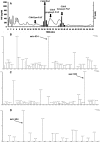Platelet-activating factor acetylhydrolase and transacetylase activities in human aorta and mammary artery
- PMID: 18587071
- PMCID: PMC2533414
- DOI: 10.1194/jlr.M800188-JLR200
Platelet-activating factor acetylhydrolase and transacetylase activities in human aorta and mammary artery
Abstract
Platelet-activating factor (PAF), the potent phospholipid mediator of inflammation, is involved in atherosclerosis. Platelet-activating factor-acetylhydrolase (PAF-AH), the enzyme that inactivates PAF bioactivity, possesses both acetylhydrolase and transacetylase activities. In the present study, we measured acetylhydrolase and transacetylase activities in human atherogenic aorta and nonatherogenic mammary arteries. Immunohistochemistry analysis showed PAF-AH expression in the intima and the media of the aorta and in the media of mammary arteries. Acetylhydrolase and transacetylase activities were (mean +/- SE, n = 38): acetylhydrolase of aorta, 2.8 +/- 0.5 pmol/min/mg of tissue; transacetylase of aorta, 3.3 +/- 0.7 pmol/min/mg of tissue; acetylhydrolase of mammary artery, 1.4 +/- 0.3 pmol/min/mg of tissue (P < 0.004 as compared with acetylhydrolase of aorta); transacetylase of mammary artery, 0.8 +/- 0.2 pmol/min/mg of tissue (P < 0.03 as compared with acetylhydrolase of mammary artery). Lyso-PAF accumulation and an increase in PAF bioactivity were observed in the aorta of some patients. Reverse-phase HPLC and electrospray ionization mass spectrometry analysis revealed that 1-O-hexadecyl-2 acetyl-sn glycero-3-phosphocholine accounted for 60% of the PAF bioactivity and 1-O-hexadecyl-2-butanoyl-sn-glycerol-3-phosphocholine for 40% of the PAF bioactivity. The nonatherogenic properties of mammary arteries may in part be due to low PAF formation regulated by PAF-AH activity. In atherogenic aortas, an imbalance between PAF-AH and transacetylase activity, as well as lyso-PAF accumulation, may lead to unregulated PAF formation and to progression of atherosclerosis.
Figures





Similar articles
-
Platelet-activating factor acetylhydrolase and transacetylase activities in human plasma low-density lipoprotein.Biochem J. 2001 Jul 15;357(Pt 2):457-64. doi: 10.1042/0264-6021:3570457. Biochem J. 2001. PMID: 11439095 Free PMC article.
-
The role of platelet-activating factor-dependent transacetylase in the biosynthesis of 1-acyl-2-acetyl-sn-glycero-3-phosphocholine by stimulated endothelial cells.J Biol Chem. 1997 Jul 11;272(28):17431-7. doi: 10.1074/jbc.272.28.17431. J Biol Chem. 1997. PMID: 9211886
-
Molecular and mechanistic characterization of platelet-activating factor-like bioactivity produced upon LDL oxidation.J Lipid Res. 2005 Sep;46(9):1923-32. doi: 10.1194/jlr.M500074-JLR200. Epub 2005 Jul 1. J Lipid Res. 2005. PMID: 15995176
-
Platelet activating-factor acetylhydrolase II: A member of phospholipase A2 family that hydrolyzes oxidized phospholipids.Chem Phys Lipids. 2021 Sep;239:105103. doi: 10.1016/j.chemphyslip.2021.105103. Epub 2021 Jun 8. Chem Phys Lipids. 2021. PMID: 34116047 Review.
-
Effect of acyl and alkyl analogs of platelet-activating factor on inflammatory signaling.Prostaglandins Other Lipid Mediat. 2020 Dec;151:106478. doi: 10.1016/j.prostaglandins.2020.106478. Epub 2020 Jul 22. Prostaglandins Other Lipid Mediat. 2020. PMID: 32711129 Review.
Cited by
-
Macroalgal Proteins: A Review.Foods. 2022 Feb 16;11(4):571. doi: 10.3390/foods11040571. Foods. 2022. PMID: 35206049 Free PMC article. Review.
-
Phospholipase A2 enzymes: physical structure, biological function, disease implication, chemical inhibition, and therapeutic intervention.Chem Rev. 2011 Oct 12;111(10):6130-85. doi: 10.1021/cr200085w. Epub 2011 Sep 12. Chem Rev. 2011. PMID: 21910409 Free PMC article. Review. No abstract available.
-
Advanced Maternal Age Worsens Postpartum Vascular Function.Front Physiol. 2017 Jun 30;8:465. doi: 10.3389/fphys.2017.00465. eCollection 2017. Front Physiol. 2017. PMID: 28713290 Free PMC article.
-
Lipoprotein-associated phospholipase A2: The story continues.Med Res Rev. 2020 Jan;40(1):79-134. doi: 10.1002/med.21597. Epub 2019 May 29. Med Res Rev. 2020. PMID: 31140638 Free PMC article. Review.
References
-
- Prescott S. M., G. A. Zimmerman, D. M. Stafforini, and T. M. McIntyre. 2000. Platelet-activating factor and related lipid mediators. Annu. Rev. Biochem. 69 419–445. - PubMed
-
- Montrucchio G., G. Alloatti, and G. Camussi. 2000. Role of platelet-activating factor in cardiovascular pathophysiology. Physiol. Rev. 80 1669–1699. - PubMed
-
- Honda Z., M. Nakamura, I. Miki, M. Minami, T. Watanabe, Y. Seyama, H. Okado, H. Toh, K. Ito, T. Miyamoto, et al. 1991. Cloning by functional expression of platelet-activating factor receptor from guinea-pig lung. Nature. 349 342–346. - PubMed
-
- Izumi T., and T. Shimizu. 1995. Platelet-activating factor receptor: gene expression and signal transduction. Biochim. Biophys. Acta. 1259 317–333. - PubMed
-
- Tanaka T., M. Iimori, H. Tsukatani, and A. Tokumura. 1994. Platelet-aggregating effects of platelet-activating factor-like phospholipids formed by oxidation of phosphatidylcholines containing an sn-2-polyunsaturated fatty acyl group. Biochim. Biophys. Acta. 1210 202–208. - PubMed
Publication types
MeSH terms
Substances
LinkOut - more resources
Full Text Sources
Miscellaneous

